Shipwreck S/S Citta di Tripoli
-

The Italian two propeller passenger steam ship Città di Tripoli before its requisition. (© Archivio Francesco De Domenico. -

The ship’s stern in the sea bottom. (© Kostas Milonakis) -
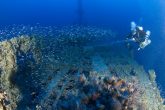
At the area of the second line of the superstructures. (Kostas Milonakis) -
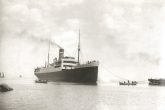
Città di Tripoli in 1915 in Ancona during its launching. (© Archivio Francesco De Domenico) -

Registration in the war diary of the German Marine Administration of the South (Admiral Südost - Marinegruppenkommando Süd) on 02.07.1941 mentioning the sinking of Città di Tripoli. (NARA – Archive D. Galon) -
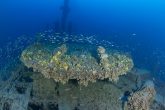
A big round structure is evident at the fantail of the ship on which there were placed, or it was planned to do so, one or more marine firearms. (© Kostas Milonakis) -
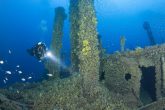
At the area of the second line of the superstructures at the middle ship. (© Kostas Milonakis) -
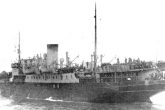
Città di Tripoli during its requisition by the Italian Government. (© Archivio Giorgio Spazzapan) -

Places of habitation at the second line of superstructures at the area of the middle ship. (© Kostas Milonakis) -

The area of the middle ship were the open skylights of the engine room are evident. (© Kostas Milonakis) -

The stern from where we can see a part of the fantail. (© Kostas Milonakis) -
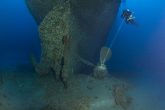
The stern from where we can see the propellers and the rudder turned to the left. (© Kostas Milonakis) -

The British submarine HMSM Torbay. (© Archive D. Galon) -
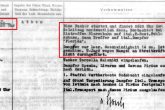
Registration in the war diary of the German Marine Administration of the Aegean Sea where it is mentioned the operation of a Fokker aircraft in order to find and support the Italian convoy in which Città di Tripoli belonged. (NARA – Archive D. Galon) -
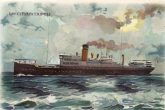
Città di Tripoli on a postcard. -

Video from the shipwreck S/S Citta di Tripoli.
The Italian passenger steamship Città di Tripoli
On April 24th 2010, Antonis Grafas and his team dived in an unknown until then wreck at the north-west side of the island of Kea, the position of which was kindly given by the diving team of Nikos Vassilatos and Eleni Tsopouropoulou. The visual material that Antonis brought led to the identification of the wreck of the two-propeller Italian steamship Città di Tripoli that was torpedoed by the British submarine HMSM Torbay and sank on July 2nd 1941 while it was heading, as part of a convoy, from Vathi in Samos to Piraeus. After that first dive and during the following years, six more dives took place in order to collect more visual material and to enhance the effort of the validation of the wreck. This material combined with the rich registrations of the war diaries, the relevant references in the Italian, British and German files as well as the testimonials of the witnesses through the relevant bibliography led not only to the restoration of the ship’s history but also to the attempt of a detailed simulation of the history of its sinking.
S/S Città di Tripoli
The Italian passenger steamship Città di Tripoli, registered with the reference number 392 at Napoli in Italy, was constructed in 1915 at Ancona in the Cantieri Navali Riuniti shipyards with construction number 62. Società di Navigazione Sicilia based in Palermo, Sicily, was the offeror company. In 1926 the ship was sold to the well known Italian ship company CITRA (Compagnia Italiana Transatlantica) and from 1932 belonged to the ship company Tirrenia (Flotte Riunite Florio e Citra) based in Genoa. From 1937 until its sinking the ship belonged to the Tirrenia Società Anonima di Navigazione based in Napoli. The general characteristics of Città di Tripoli were:
Type: Passenger/ Cargo Ship
Flag: Italian
Gross Tonnage: 2933
Net Tonnage: 1586
Total Length: 96,3m
Width: 12,5m
Draught: 6,4m
Impulse: Six cylinder steam engine
Power: 378 NHP
Propellers: 2
Indicative Speed: 13,5 knots
The ship, which since 1937 had changed its heating system of its generators from coal to oil, was commanded by the Italian Government on December 22nd 1940 at Napoli and was transferred during spring of 1941, and after the occupation of Greece by the Axis Alliance, to the Aegean Sea as a carrier troopship of the Italian army.
The sinking
During the night of July 1st 1941, Città di Tripoli started its voyage empty from Vathi in Samos, where it had disembarked army for the patrol of the island, to Piraeus as final destination. The ship was part of a convoy with the Italian passenger cargo steam ship Città di Savona (gross tonnage of 2500) accompanied by the Italian torpedo ship LIBRA (F552). The Italian Marine Administration of the Aegean Sea (Comando Gruppo Navale dell’Egeo Settentrionale) had additionally requested by the German Marine Administration of the Aegean (Stab des Admirals Ägäis) the contribution of a detecting aircraft for the morning of July 2nd 1941 in order to supervise by the air the convoy due to the fear of a possible torpedo attack by British submarines.
At around 06.20am on July 2nd 1941, the German type Fokker aircraft, that was sent to find the convoy that finally met at the north-west of the island of Kea, detected on the water surface the trace of a torpedo heading towards the preceding torpedo ship LIBRA (F 552). The torpedo though did not find its target. After that it detected an explosion in one of the carriers of the convoy that then sank. It was the Città di Tripoli that had 59 persons on board from which 11 died while 48 persons were saved and collected by Città di Savona also part of the convoy.
Right after the torpedo attack, the accompanying torpedo ship LIBRA (F552) headed to the point from where the torpedoes were released and started an anti-submarine chase with depth charges against the enemy submarine. Even though 18 depth charges were released, there was no sufficient evidence to prove that the submarine sank. After the war, the war diaries and the archive registrations certainly and precisely showed that the torpedo attack against the Italian convoy that had as a result the sinking of Città di Tripoli was realized by the British submarine HMSM Torbay that was under the commands of the Lieutenant Commander Anthony Miers and loomed that day at the area of Kea.
HMSM Torbay
The British submarine HMSM Torbay was constructed at the Chatam Dockyard in England and was launched on April 9th 1940. It was the last of the 15 submarines of Triton Class type that were constructed between 1936 and 1940 for the British Royal Navy. HMSM Torbay had a very successful history as it managed to sink 17 merchant ships of a total gross tonnage of 38.000 g.r.t, 5 war ships and 24 motor ships. It started on January 15th 1941 under the commands of the captain Lieutenant Commander Anthony Miers, under the nick name “Crap“, who was crowned as a knight of the category KBE (κυβερνήτη Lieutenant Commander Anthony Miers), acquiring the title of Sir. After some short missions to the Bay of Biscay and the Atlantic Ocean (22.03.1941–13.04.1941), it headed, after the order of the British Marine Administration, to the Mediterranean Sea with final destination Alexandria, where it was integrated in the 1st fleet of submarines that was based there (1st Submarine Flotilla – Alexandria –Egypt). HMSM Torbay stayed at the east and central Mediterranean operating many missions and patrols. A significant one is the Flipper Operation (Operation Flipper, November 1941) that was realized in cooperation with the submarine HMSM Talisman as well as an attack against a convoy of the Axis Alliance at the Corfu channel in March 1942. During this attack, the submarine stayed in enemy waters for 17 hours and this is why Anthony Miers, the submarine’s captain, was awarded with the Victoria Cross.
In summer 1942, HMSM Torbay travelled to England where many changes to its equipment were realized and in February 1943 returned to the Mediterranean under the commands of the new captain Lieutenant Commander Robert Clutterbuck (8th Flotilla – Algeria). After the completion of the war operations in the Mediterrenean, HMSM Torbay went to the Far East where it participated in the operations of the 2nd fleet of the British Royal Navy (2nd Flotilla – East India Fleet) at Sumatra, Thailand under the commands of Lieutenant Compton Patrick Norman. After the end of the war, it was sold for breaking up that was realized in Briton Ferry of Wales in March 1947. It is worth mentioning that HMSM Torbay and HMSM Trident are the only submarines from the 15 of Triton type that stayed undamaged from the war.
The history and successes of HMSM Torbay are directly connected to its first controversial captain Mr. Anthony “Crap” Miers. In these successes, two facts are also included for which Miers was berated by the British Marine Administration and accused of being a war criminal by the German side. This is about the attacks that HMSM Torbay realized on July 4th and 9th 1941 exactly after the sinking of S/S Città di Tripoli. The first attack was against two Greek motor ships that were commanded by the German army at the west side of Lesvos and the second attack was against a small fleet of four commanded Greek motor ships at the north side of Antikithira. For both attacks, Anthony Miers was accused of executing in cold blood the survivors with machine gun shots refusing to arrest them as hostages.
The attack
According to the file registration in the war diary of the British Marine Administration [1], the attack of HMSM Torbay, operated by the captain Anthony Miers, was realized as follows:
“02.07.1941, time 06:38 [2]: seeing from an angle of 295 degrees the cape of Aghios Nikolaos in Kea and in a distance of 4,9 nautical miles away from it, two ships accompanied by a Libra destroyer and an Arado 95 aircraft were detected.
Time 06.50: the convoy changed direction following a track of 255 degrees in order to reach the south side of the cape of Agalistro (island of Makronisos). The submarine, being in a quite long distance from the enemy track and as the sea was calm and the accompanied aircraft was close enough, decided to attack from a long distance as any speed increase could jeopardize the success the operation.
Time 07.22: seeing from an angle of 304 degrees the cape of Aghios Nikolaos in Kea and in a distance of 4,5 nautical miles away from it, three torpedoes were released against the first ship with a direction of 90 degrees. The attack route was estimated to be at 255 degrees and the speed was 8 knots.
Time 07.24: three torpedoes were released against the last ship and the submarine immediately dived in changing the route towards the north-east side.
Time: 07.25: the first ship was shot by a torpedo. Due to the long distance and the calm sea, it is possible that the second ship changed its route in order to avoid the torpedoes. The distance was so long that was impossible to recognize the nationality of the enemy; however the ships looked like passenger ships with high superstructures, having both of them double masts and one funnel. The first one was about 4000 tones and the second one was smaller, probably of 2000 tones.
Time 07:30 – 08:40: the submarine was chased by the accompanied Italian destroyer that shoted 18 depth charges from a long distance and then it changed its route.
Time 21.50: the submarine was emerged – seeing from an angle of 155 degrees the island of Kavo Doro and being in a distance of 6,8 nautical miles from it- and then continued its route towars Mitilini.”
This description is also enhanced by the testimonial of the second officer of the British submarine Paul Chapman [3]:
“In July 2nd, two ships of the Navy accompanied by two destroyers appeared in Kea – the specific area is south of the straights of Kavo Doro between the island of Kea and the mainland. The sea was very calm. The previous day we had realized that we could see details of the hull of our ship through the periscope. Three torpedoes to each merchant ship were released. The preceding ship, that was later proven to be Città di Tripoli, was hit and sank at 07.22. the second ship avoided the torpedo being already warned by the first one. The counter attack that was realized with 18 depth charges was proven unsuccessful.“ [4]
The wreck
The wreck of Città di Tripoli is located in an upright position in the sea bottom on its keel in a maximum depth of 117m and a minimum of 98m. The imaginary bow-stern line of the ship has a north west direction. Despite the long stay of the ship in the sea bottom (over 70 years), the condition of the ship as well of its superstructures is very good. The anchors are in their position and at the right side of the ship, at the area of the middle ship, the crack caused by the torpedo of the HMSM Torbay is evident. The two three-wing propeleers of the ship are also in their position and the rudder is turned to the left. At the fantail of the ship there is a big round structure on which there were placed, or at least it was planned to do so, one or more marine fire arms. Generally, the general as well as the details characteristics of the wreck are still evident. The particularities of the first and the second superstructure lines, the forecastle, the fantail and the position of the airways are evident and they absolutely confirm the identity of the wreck to be Città di Tripoli.
The wreck of Città di Tripoli is undoubtly a historic witness that belongs to the big series of historic wrecks located at the area of Kea. Along with the already know wrecks of HMHS Britannic, S/S Burdigala and M/V Theophile Gautier , Città di Tripoli is also part of the touchable remains of the two big wars that have a great historic significance due to their role in the marine and war status of the east Mediterranean. The on the spot research combined with the archive research is usually able to transform a bunch of rusty sheet metals located for years in the sea bottom into a historic object with time existence, identity and a long past. In this category, the Italian passenger steam ship Città di Tripoli that adorns the sea bottom at the north-west side of Kea also belongs.
DG
References, Supplementary Material and Clarifications
[1] See ADM 236/32
[2] There was one hour difference between the British and the German “operational hour”
[3] See Chapman, Paul: Submarine Torbay, p. 61
[4] The evident small contradictions between the testimonial of Paul Chapman and the British diary registrations regarding the number of the ships of the convoy are probably due to the fact that Chapman wrote his book after the war and maybe he did not remember all the details.
Sources
ADM 199/1152, ADM 236/32, The National Archives, Kew
Ando, Elio / Bagnasco, Erminio: Marina Italiana: Le Operazioni nel Mediterraneo Giugno 1940 – Giugno 1942, Bolognia, Intergest, 1976
Bollettino AIDMEN volumes 17 to 19
Cancila, Orazio: La Società di navigazione “Tirrenia (Flotte Riunite Florio – Citra)” 1932/1936, Economia e Credito, (1/2) 1992
Chapman, Paul: Submarine Torbay, Robert Hale – London, 1989
Fioravanzo, Giuseppe: Le Azioni navali in Mediterraneo. Dal 1 aprile 1941 al 8 settembre 1943, Roma, Ufficio Storico della Marina Militare, 2001
Kemp, Paul: The T-Class submarine – The Classic British Design, Arms and Armour 127, 1990
Kriegstagebuch Admiral Ägäis
Kriegstagebuch Kommandant der Seeverteidigung Attika
Kriegstagebuch Marinegruppenkommando Süd
Lloyds Register of Shipping
Lupinacci, Pier Filippo (Compilatore), Tognelli, Vittorio E. (Revisore): La difesa del traffico l´Albania, la Grecia e l´Egeo, La Marina italiana nella seconde Guerra mondiale, Ufficio Storico della Marina Militare, Vol. IX, Roma, 1965
Notarangelo, Rolando / Pagano, Gian Paolo: Navi mercantili perdute, Ufficio Storico della Marina Militare
Ntounis, Christos: The Wrecks in the Greek Seas, Finatec 2000
Projekt ASA, Allied Submarine Attacks, Historisches Marinearchiv
Rohwer, Jürgen: Allied Submarine Attacks of World War Two, Naval Institute Press, Annapolis, Maryland, 1997

